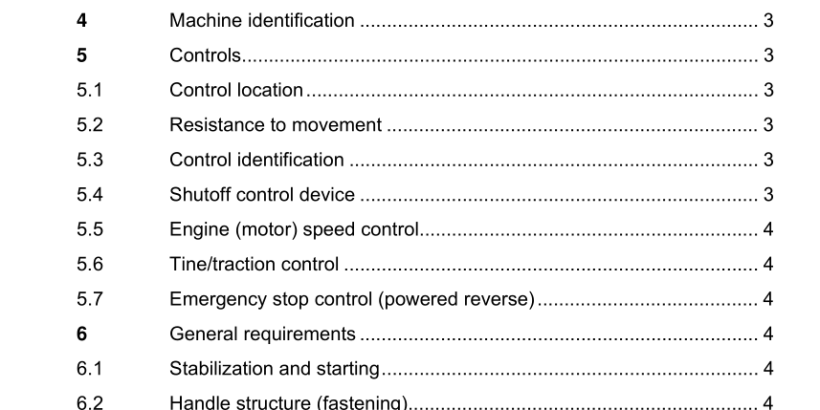ANSI B71.8-2016 pdf download.Powered Walk-Behind Rotary Tillers and Hand-Supported Cultivators – Safety Specifications
7.3.2 Test procedure
The test shall be conducted in the shade with a wind speed not to exceed 3 m/s (6.7 mi/h). The engine shall be operated at its maximum operating engine speed with the tines engaged until the surface temperatures stabilize. All guards shall be in their normal operating position during this test. Temperatures shall be determined by correcting the observed temperature by the difference between 20ºC (68°F) and the ambient test temperature. When the distance between the identified hot area and the nearest control is in excess of 100 mm (3.9 in), cone A as shown in figure 6 shall be used. For distances less than or equal to 100 mm (3.9 in) between the identified hot area and the nearest control, cone B in figure 6 shall be used. For cone A, with the axis of the cone anywhere between 0 and 180° to the horizontal and with the nose or point of the cone in a downward to horizontal direction, move the cone towards the hot surface. The nose of the cone shall not be pointed in an upward direction. When moving the cone, determine if contact is made with the hot surface area(s) with the cone tip or conical surface of the cone. Cone B shall be used with the axis of the cone in any direction and moved in any direction. NOTE: It is not necessary to test the accessibility of hot parts while they are hot. Allow the hot parts to cool before using the cone(s).
7.4 Engine exhaust
Exhaust gases shall not be directed toward the operator zone.
8 Servicing instructions
A manufacturer shall supply, with the equipment, instructions for safe servicing and maintenance, such as
shown in figure 7. Instructions may be tailored to the specific machine design.
Specific written or illustrative instructions with appropriate safety warnings shall be provided with the
equipment for those servicing operations recommended by the manufacturer that must be performed with
the engine running.
9 Electrical requirements
9.1 General
The specifications given in this standard are not intended to completely cover electrical requirements.
9.2 Line voltage circuits
All line-operated electrical components shall comply with the applicable electrical requirements contained
in ANSI/UL 82.
9.3 Low-voltage battery-powered circuits (not including magneto grounding circuits)
9.3.1 Insulated cable
Insulated cable shall meet the requirements of SAE J1128. The wiring shall be properly supported and located to prevent possible damage by cutting, abrasion, or heat.
9.3.2 Battery installation
The compartment for a vented storage battery shall be vented and provide for drainage of acid from the compartment. Drainage of acid from the battery in operating position shall not come in contact with parts that will be critically affected in such a manner as to create a hazard.
9.3.3 Overload protection
All circuits, except starting motor and ignition circuits, shall have overload protective devices on the battery-feed side of switches, except that, for two-wire, nongrounded systems, the overload protection may be located in either line. (See SAE J554, SAE J156, and SAE J553.)
9.3.4 Terminals and noninsulated electrical parts
Terminals and noninsulated electrical parts shall be protected against shorting during normal servicing, refueling, and lubrication.
9.4 High-tension cable
High-tension cable shall meet the requirements of SAE J2031.
10 Label durability requirements
10.1 General
Required labels shall be certified by the machine manufacturer to meet the following label durability requirements. Permanent safety signs are considered to have a reasonable life if the sign has good color and legibility for a period of at least five years. Exterior durability is based on vertical exposure tests for weatherability in the extreme climate of the United States, or a 2000 h carbon-arc test in accordance with ASTM G152 (Cycle 1), or a 2000 h xenon-arc test in accordance with ASTM G155 (Cycle 1). Other test methods, including ANSI/UL 969, may be used providing the method ensures equal or superior sign durability.ANSI B71.8-2016 pdf download
